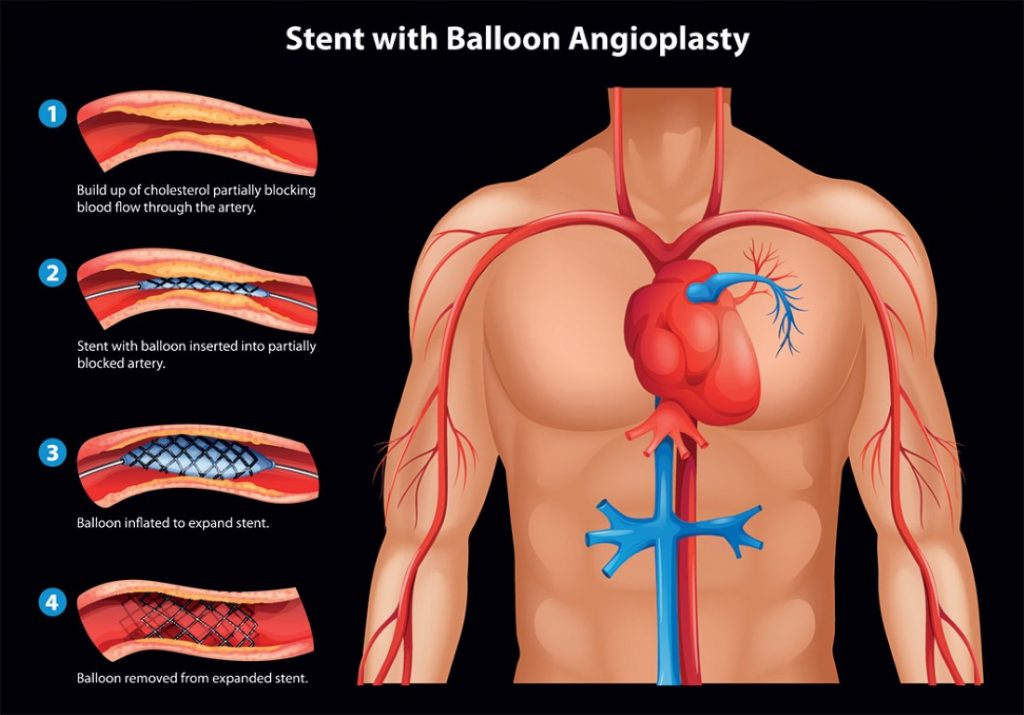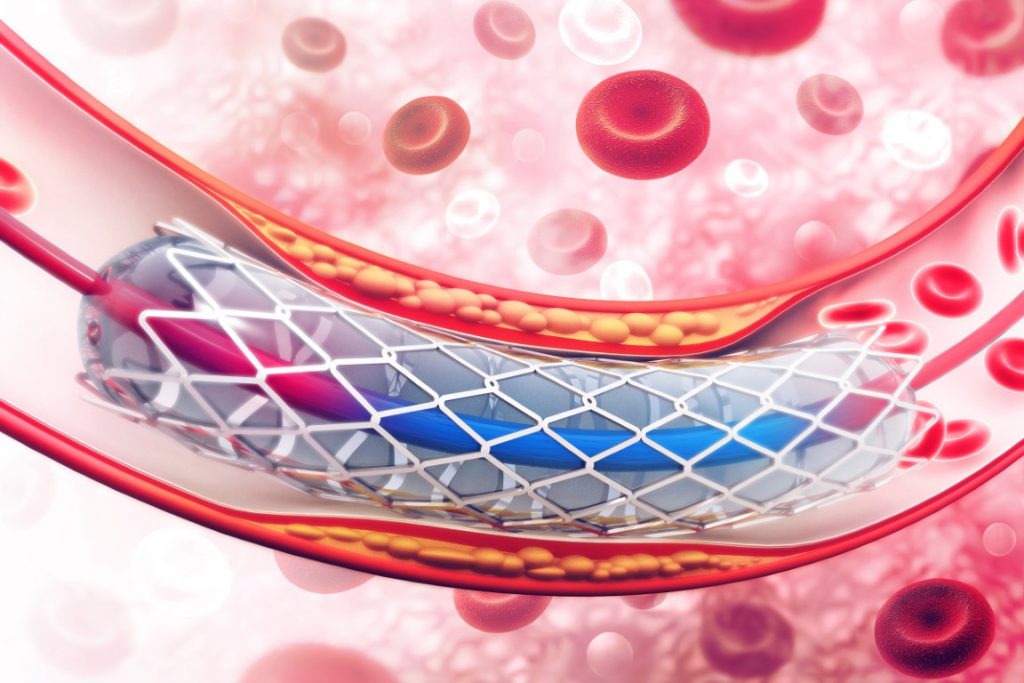A stent resembles a tiny tube, which is used to treat diseases where the blood vessels get clogged due to the accumulation of fat, cholesterol and even calcium. Normally, these blood vessels are involved in supplying blood to the rest of the body from the heart, including the heart muscles. The majority of the stents are composed out of wire mesh and are permanent. Some stents used for bigger blood vessels are also composed of fabric and are termed as stent-grafts.
A different class of stents is manufactured from materials that get dissolved or absorbed over time in the body. Stents are implanted within the affected blood vessels, which prevents them from getting blocked. Stents are also available in a drug-coated variant, where they are coated with drugs that slowly get released in the bloodstream. These drugs prevent the blood vessels from getting blocked.
Why a stent is required?
In case fats present in the body get collected inside an artery, it can decrease the flow of blood to your heart itself and can lead to chest pain and eventually cause heart disease. Also, the accumulated contents in the vessel lumen (referred to as plaque) can lead to the formation of a blood clot, which upon rupturing, can block the vessel and disrupt the normal blood flow to the heart and can lead to a heart attack due to the death of the tissues which are deprived of blood. Stents reduce your subsequent risk of heart vessel disease and can be used even for treating an ongoing heart attack.
What are the different types of stents?
There are two primary types of stents: 1) Bare Metal Stents (BMS) 2) Drug-eluting Stents (DES). BMS gives support to the blood vessel to aid in preventing its blockage post angioplasty. On the other hand, A DES is a BMS coated with a unique drug coating added for reducing the risk of re-blocking of arteries. In a DES, the drug gradually gets released from the drug coating overtime preventing the reformation of blockages during the maximal risk period, wherein a block can be formed. In a DES, the stent is coated with a special polymer, which contains and preserves the drug during the stent placement procedure. As soon as the stent is placed, it aids in controlling the release of the drug into the blood vessel walls. In this way, the polymer helps in an equally distributed drug release from the stent. The polymer for DES is designed to permit a consistent and controlled drug release from the surface of the stent into the walls of the artery. There are two types of drug-eluting stents:
- Permanent Polymer DES: In this type of stent, the polymer stays on the stent permanently, even after all the drug has been released.
- Bioabsorbable Polymer Drug-Eluting Stent: In this type of stent, the polymer degrades shortly with the release of the drug. This helps better healing by eliminating long-term polymer exposure.
The doctor may prefer a BMS or a DES based on the unique needs of each patient. Each type of stents has its inherent advantages and drawbacks which should be discussed well in advance with the doctor. A DES cannot be used in you in the following cases:
1) You are allergic to the drug, the polymer or metals (stainless steel, platinum, chromium, cobalt, etc.) used in the stent.
2) You cannot tolerate anti-clotting or anti-platelet drugs.
3) You have a blockage that does not permit proper stent placement.
4) Your doctor feels you are not suitable for stent placement for a particular reason. Still, stent placement is associated with complications like any other invasive procedure.
Process of stent implantation
- Your doctor will first make a small cut in a blood vessel located in your abdomen, arm, or neck to insert a stent in your body.
- He/she then inserts a small tube known as a catheter through the vessel to the artery which is clogged. The tube contains a tiny balloon at its end, that your doctor will inflate in your clogged artery. This process will widen your artery and restore the blood flow through the deprived portion. The stent will then be placed inside the artery and the rest of the contents (balloon and catheter) will be taken out. The placed stent will keep the artery open to keep the usual blood flow. The entire process is estimated to last only an hour but mostly, you will be required to stay in the hospital for a night for observation of any adverse events.
- Risks may include:
1) Hemorrhage at the spot of tube insertion.
2) Blood vessel damage at the time of insertion.
3) Infection.
4) Arrhythmia i.e.Improper beating of the heart, whether irregular, too fast or too slow.
5) On rare occasions (1-2%), people who are implanted with a stent, develop a clot at the stent placement site, further elevating the risk of occurrence of a heart attack (myocardial infarction) or stroke. This risk is maximum during the first couple of months of post-procedure. Hence, your doctor will recommend you to take aspirin or any other blood thinners to prevent clot formation.



What are dissolving stents and what are their benefits?
Traditional metal stents have been associated with several drawbacks for a long time. A metallic stent needs to be placed permanently in the blood vessel for the prevention of re-narrowing or post dilating a clogged artery with a balloon. However, the permanent presence of a metal stent forms a core for forming a clot of blood within the stent which could be fatal for the patient. The principle behind a dissolving or a bioresorbable stent is to overcome the drawbacks of metallic stents. It prevents re-occurrence of narrowing during the period of maximum risk and ultimately gets dissolved withdrawing the risk of formation of any blood clot.
Are stents effective in the long term in reducing the chance of another heart attack?
Yes, certain stents (DES) can reduce the chances of future heart attacks to some extent but regular medicine intake and lifestyle modifications are the most vital components in reducing the risk of a heart attack even after stent implantation.
How long does a stent last?
A stent is a tube-like structure and normally metallic. It is designed to maintain the lumen of the blood vessel. Coronary arteries are the blood vessels that carry blood to the heart muscle. Stents are placed through a procedure in which a catheter is placed in the artery present in the abdomen and guided up to the heart. An angioplasty where the narrowed artery due to blockage is dilated via a balloon dilation normally happens before the stent placement.
Some patients with stents implanted 30 years ago are performing normally even now. However, stents can also develop blockages. Lately, drug-eluting stents have been used largely in patients to prevent the development of blockages after stent placement. These stents are coated with drugs to lessen the risk of formation of blockages. Patients who already get stents implanted carry the risk of blockages at different locations in different arteries. Aspirin therapy and control of cholesterol and triglycerides through diet, medicine or both do appear to decrease risk.
Harms/Risks of Stenting
- You may get an allergic reaction
- Angioplasty can lead to hemorrhage, blood vessel damage, or even heart damage, or arrhythmia.
- Rarely, some potential complications such as heart attack, stroke, or renal failure can also occur.
- A scar tissue formation can happen inside your stent post stenting procedure necessitating another procedure for removing it.
- Stenting also carries a risk of blood clot formation which needs medicines for prevention.
- It cannot ultimately cure your CAD. You have to continue managing your contributing risk factors for CAD such as hypertension, overweight, diabetes, or high cholesterol to prevent a future event.



Living with Stent
- Saves your life and alleviates damage to your heart muscles at the time of heart attack by replenishing blood flow to your heart.
- Immediately relieves/decreases symptoms of heart disease.
- Reduces the risk of heart attack or stroke in the future.
- Stent placement may diminish your requirement of a CABG (Coronary Artery Bypass Grafting).
- Stenting is comparatively much less invasive versus CABG and also has a much short-lived recovery period.




